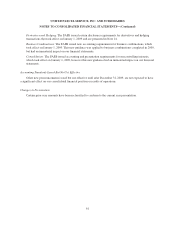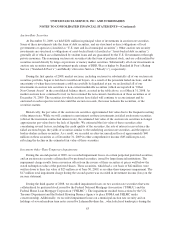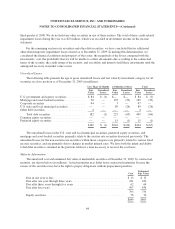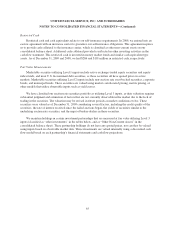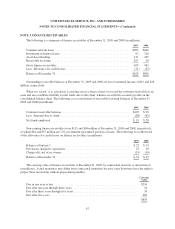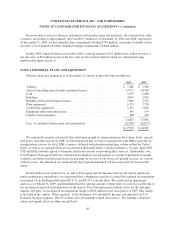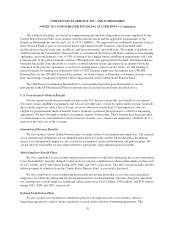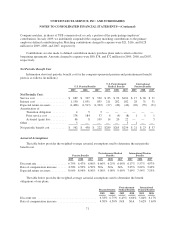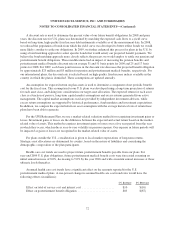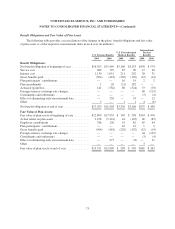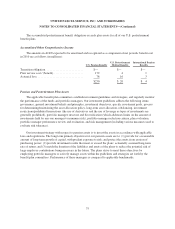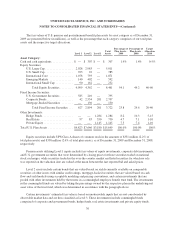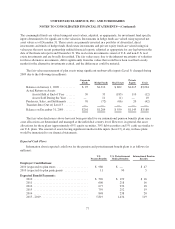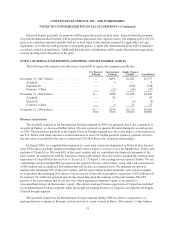UPS 2009 Annual Report Download - page 82
Download and view the complete annual report
Please find page 82 of the 2009 UPS annual report below. You can navigate through the pages in the report by either clicking on the pages listed below, or by using the keyword search tool below to find specific information within the annual report.UNITED PARCEL SERVICE, INC. AND SUBSIDIARIES
NOTES TO CONSOLIDATED FINANCIAL STATEMENTS—(Continued)
The withdrawal liability was based on computations performed by independent actuaries employed by the
Central States Pension Fund, in accordance with the plan document and the applicable requirements of the
Employee Retirement Income Security Act of 1974 (“ERISA”). We negotiated our withdrawal from the Central
States Pension Fund as part of our national master agreement with the Teamsters, which included other
modifications to hourly wage rates, healthcare and pension benefits, and work rules. We sought to negotiate our
withdrawal from the Central States Pension Fund, as we believed the fund would likely continue to have funding
challenges, and would present a risk to UPS of having to face higher future contribution requirements and a risk
to the security of the pension benefits of those UPS employees who participated in the fund. We believe that we
benefited financially from the ability to achieve a ratified national master agreement seven months before the
expiration of the previous agreement, as well as by gaining better control over the future cost and funding of
pension benefits by limiting our obligations solely to UPS Teamster employees through the new UPS IBT
Pension Plan. As the UPS IBT Pension Plan matures, we believe that it will become cost beneficial from a cash
flow and earnings standpoint compared with having remained in the Central States Pension Fund.
The UPS Excess Coordinating Benefit Plan is a non-qualified plan that provides benefits to certain
participants in the UPS Retirement Plan for amounts that exceed the benefit limits described above.
U.S. Postretirement Medical Benefits
We also sponsor postretirement medical plans in the U.S. that provide health care benefits to our retirees
who meet certain eligibility requirements and who are not otherwise covered by multi-employer plans. Generally,
this includes employees with at least 10 years of service who have reached age 55 and employees who are
eligible for postretirement medical benefits from a Company-sponsored plan pursuant to collective bargaining
agreements. We have the right to modify or terminate certain of these plans. These benefits have been provided
to certain retirees on a noncontributory basis; however, in many cases, retirees are required to contribute all or a
portion of the total cost of the coverage.
International Pension Benefits
We also sponsor various defined benefit plans covering certain of our international employees. The majority
of our international obligations are for defined benefit plans in Canada and the United Kingdom. In addition,
many of our international employees are covered by government- sponsored retirement and pension plans. We
are not directly responsible for providing benefits to participants of government-sponsored plans.
Multi-Employer Benefit Plans
We also contribute to several multi-employer pension plans for which the subsequent disclosure information
is not determinable. Amounts charged to operations for pension contributions to these multi-employer plans were
$1.125, $1.069, and $7.642 billion during 2009, 2008, and 2007, respectively. The 2007 amount includes the $6.1
billion payment to withdraw from the Central States Pension Fund, as previously discussed.
We also contribute to several multi-employer health and welfare plans that cover both active and retired
employees for which the subsequent disclosure information is not determinable. Amounts charged to operations
for contributions to multi-employer health and welfare plans were $1.031 billion, $990 million, and $919 million
during 2009, 2008, and 2007, respectively.
Defined Contribution Plans
We also sponsor several defined contribution plans for all employees not covered under collective
bargaining agreements, and for certain employees covered under collective bargaining agreements. The
70



